Vertical & Horizontal of Cappellano’s Barolos: 1927 to 2010
Location: Giando Italian Restaurant, Star St, Pacific Place 3
Time: 7pm
Price:
Reply-to:
NB: Confirmed seats inset, please contact Nigel only in case of error
Dear Jamie,
This is the first exclusive tasting by the HKWS of Cappellano’s barolos. Cappellano is one of the greatest producers in all of Barolo, and they’ve never received a 100, 95 or even a 90-point score from any modern-day Italian wine critic. The decision to reject the scoring of critics came from Teobaldo Cappellano in 1983, who believed winemaking a be an art form, a work of passion, and one that should not be encapsulated into a single number. Nor did he believe that it was healthy for fellow producers, seeing it as being divisive. Teobaldo passed on in 2009, but his work is being continued by his son. Augusto
This event benefits from Alan Kwok’s relationship with Cappellano going back some years. The wines will reflect 2 eras of Cappellano: the traditional single-label ‘Barolo’ period, from 1927 to 1993, and then modern period when the two classic pareels that have garnered even more acclaim for the wines of Cappellano: Barolo “Rupestris,” from a parcel planted on grafted rootstock in the 1940s which produce a Barolo of superb depth of colour and remarkable richness and length, and the now almost mythic “Piè Franco,” from a parcel planted in 1989 on its own roots – i.e. ‘franc de pied - with Nebbiolo’s “Michet” clone.
Tasting wines : single-bottle tasting
Cappellano Barolo DOCG, NEBBIOLO, Piedmont 1927
Cappellano Barolo DOCG, NEBBIOLO, Piedmont 1939
Cappellano Barolo DOCG, NEBBIOLO, Piedmont 1964
Cappellano Barolo DOCG, NEBBIOLO, Piedmont 1968
Cappellano Barolo DOCG, NEBBIOLO, Piedmont 1978
Cappellano Barolo DOCG, NEBBIOLO, Piedmont 1993
Cappellano Otin Fiorin Pie Rupestris - Nebbiolo, Barolo 2000
Cappellano Otin Fiorin Pie Rupestris - Nebbiolo, Barolo 2004
Cappellano Otin Fiorin Pie Rupestris - Nebbiolo, Barolo 2008
Cappellano Otin Fiorin Pie Rupestris - Nebbiolo, Barolo 2010
Cappellano Otin Fiorin Pie Franco - Nebbiolo, Barolo 2008
Cappellano Otin Fiorin Pie Franco - Nebbiolo, Barolo 2010
Dinner wines :
Cappellano Otin Fiorin Pie Franco - Nebbiolo, Barolo 2009
Cappellano Otin Fiorin Pie Rupestris - Nebbiolo, Barolo 2009
Cappellano Otin Fiorin Pie Rupestris - Nebbiolo, Barolo 2005
Cappellano Otin Fiorin Pie Rupestris - Nebbiolo, Barolo 2001
Cappellano Otin Fiorin Pie Rupestris - Nebbiolo, Barolo 1993
Cappellano Chinato NV
Dinner Menu
Insalata di bagna cauda: Piedimont Mix garden vegetables salad with anchovies sauce and quail egg
Ravioli alle erbe: Homemade classic Ravioli filled with Italian wild herbs and Ricotta cheese served with butter and walnuts sauce
Risotto alle quaglie: Quail Risotto with sage
Guancia di manzo brasata al vino rosso: Braised beef cheek, red wine sauce, celery roots puree and roasted red onions
Mousse al cioccolato: Chocolate mousse
The Wines of Cappellano
Barolo is an area where fiercely independent people make extraordinary wines. Yet, even in such company, Teobaldo Cappellano, who passed away on February 21, 2009, stood out for his unique philosophy, his meticulous winemaking and the profound character of his wines. A legend in Barolo—and among artisanal growers throughout Italy—Cappellano was one of the last of the region’s great traditionalist winemakers—and he was one of Barolo’s most compelling personalities. In 1983 he banished all journalists from his cellar, unless they agreed to review his wines without scores. (He saw ratings as divisive among growers.) And he may have been the only person who, during his lifetime, made a Barolo from ungrafted vines. With his passing, his son Augusto will continue Teobaldo’s important work, which includes producing the family’s renowned Barolo “Piè Franco” and Barolo “Rupestris”
The near-universal admiration accorded Cappellano was striking, given that his attitudes were often controversial. Variously described as a “wine artist,” “professional polemist,” and a “poet, philosopher and winemaker in his spare time,” he was president of the influential Vini Veri (or “true wine”) group. He was also a longtime leader of Italy’s sustainable agriculture movement. Cappellano has been compared to Bartolo Mascarello, both as a beloved figure and in the depth of his views. And his Barolos were just as firmly rooted in local traditions as were the late Mascarello’s. Cappellano made fewer than 800 cases of Barolo per year, all vinified traditionally: a fermentation of 14 to 21 days with indigenous yeasts and aging in well-seasoned botti for at least three years. His tiny production quickly disappeared into collectors’ cellars in Italy, Switzerland and Germany. As Antonio Galloni once wrote, “Cappellano’s wines are impossibly hard to find, even in neighbouring Alba.”
The Barolos that Cappellano made are classic “old-style” wines, marked by a haunting scent of dried roses and a hint of truffle. Yet, because of his stance on ratings, little has been written about them in America. He made two Barolos—both from the mythic Gabutti vineyard on Serralunga’s best slope. (A few years ago, he removed the Gabutti designation from his labels to protest the expansion of the appellation to include inferior sites.) Two-thirds of his Barolo production was Barolo “Rupestris,” from a parcel planted on grafted rootstock in the 1940s. The grapes from this parcel produce a Barolo of superb depth of colour and remarkable richness and length. His other Barolo was the mythic “Piè Franco,” from a parcel planted on its own roots with Nebbiolo’s “Michet” clone in 1989. The ethereal delicacy of this great wine made Cappellano wonder if this is what Barolo tasted like before Phylloxera.
Cappellano also continued his family’s tradition of making a small amount of their legendary elixir, Barolo Chinato, an infusion of Barolo with quinine bark, clove, wormwood and cinnamon and a small amount of cane sugar. For Cappellano, winemaking was an art. As he told Maurizio Rosso in The Mystique of Barolo, “Making Barolo is hedonism, it is art. Wine is hedonism. But wine, too, needs identity: I need to be able to say “This is Barolo.” Teobaldo Cappellano was a once-in-a-generation winemaker who not only made great wine, he encouraged us all to expect more of ourselves. His son Augusto will carry on Teobaldo’s legacy, assuring us of many more great Cappellano Barolos. Schooled by his father not only in the art, but the philosophy, of winemaking, we can expect nothing less.
HKWS Vertical & Horizontal of Cappellano’s Barolos: 1927 to 2010
-
JamieBahrain
- Posts: 3754
- Joined: Sat Aug 16, 2003 7:40 am
- Location: Fragrant Harbour.
HKWS Vertical & Horizontal of Cappellano’s Barolos: 1927 to 2010
"Barolo is Barolo, you can't describe it, just as you can't describe Picasso"
Teobaldo Cappellano
Teobaldo Cappellano
-
JamieBahrain
- Posts: 3754
- Joined: Sat Aug 16, 2003 7:40 am
- Location: Fragrant Harbour.
Re: HKWS Vertical & Horizontal of Cappellano’s Barolos: 1927 to 2010
For reference, here are Ratti's vintage tables. As per usual, wines served blind. Aeration was slow ox for older and double decanting for younger.
Thanks to Nigel and Alan for putting together an exceptional event !
Renato Ratti’s rating of tonight’s older Barolo vintages
1927: Great year: An intensely perfumed wine, correctly robust and with remarkable character
1939: Bad year (!)
1964: Great year (majestic) A magnificently balanced wine with full body, and full and intense perfume; perhaps just a little too hard, but perfect or long ageing.
1968: Good year (‘elegant’)A velvety, soft, elegantly-perfumed wine of good substance.
1978: Great year (‘majestic’). Full and robust, intensely-perfumed with delicate and harmonious flavours, good body and exceptionally-balanced velvet, grand substance and longevity.
1993: Good year. A wine with good substance and persistence, intense and characteristic perfumes, middling structure and strong tannins, ideal for medium-range ageing.
2000: Great year. A complex and structured wine with intense perfumes and a rich, fruity body supported by powerful tannins. Another marvelous vintage designed to improve with ageing.
2001: Excellent year. A very alcoholic, complete wine originating from very ripe fruit and possessing ample, rapidly-developing perfumes and good body, ideal for medium-to-long-term ageing.
Thanks to Nigel and Alan for putting together an exceptional event !
Renato Ratti’s rating of tonight’s older Barolo vintages
1927: Great year: An intensely perfumed wine, correctly robust and with remarkable character
1939: Bad year (!)
1964: Great year (majestic) A magnificently balanced wine with full body, and full and intense perfume; perhaps just a little too hard, but perfect or long ageing.
1968: Good year (‘elegant’)A velvety, soft, elegantly-perfumed wine of good substance.
1978: Great year (‘majestic’). Full and robust, intensely-perfumed with delicate and harmonious flavours, good body and exceptionally-balanced velvet, grand substance and longevity.
1993: Good year. A wine with good substance and persistence, intense and characteristic perfumes, middling structure and strong tannins, ideal for medium-range ageing.
2000: Great year. A complex and structured wine with intense perfumes and a rich, fruity body supported by powerful tannins. Another marvelous vintage designed to improve with ageing.
2001: Excellent year. A very alcoholic, complete wine originating from very ripe fruit and possessing ample, rapidly-developing perfumes and good body, ideal for medium-to-long-term ageing.
"Barolo is Barolo, you can't describe it, just as you can't describe Picasso"
Teobaldo Cappellano
Teobaldo Cappellano
-
JamieBahrain
- Posts: 3754
- Joined: Sat Aug 16, 2003 7:40 am
- Location: Fragrant Harbour.
Re: HKWS Vertical & Horizontal of Cappellano’s Barolos: 1927 to 2010

Cappellano Barolo 1939- It's hard not to be sentimental here. Harvesting of this vintage would have been in the darkest months of uncertainty in Europe. The Pact of Steel had be signed by the fascists of Germany and Italy, and the consequences of the Blitzkreig invasion of Poland through the western plains soon after must have reverberated though an impoverished rural Langhe. The region suffered terribly in WW2.
This was expected to be the 1927. It was a wine of beauty. Perfumed aromatics, delicate palate finesse loaded with mysterious fruit complexities and an enchanted drive that contrasts its limpid color.
So here goes, in a backdrop to its vibrancy and purity, these are the traditional descriptors but the wine was far more complex for words to do justice. Perfumery of red fruits, leather though not tertiary nor fresh, dried grass and faint dried Alpine herbs. The aromatics are mirrored on the palate with a fine volume of lively fruit in a lovely and fine spread and grip.
WOTN for me and the Group.
6 Firsts, 9 Seconds, 0 Lasts. 42pts
Well, shying away from traditional scoring but this must be one shy of perfection !
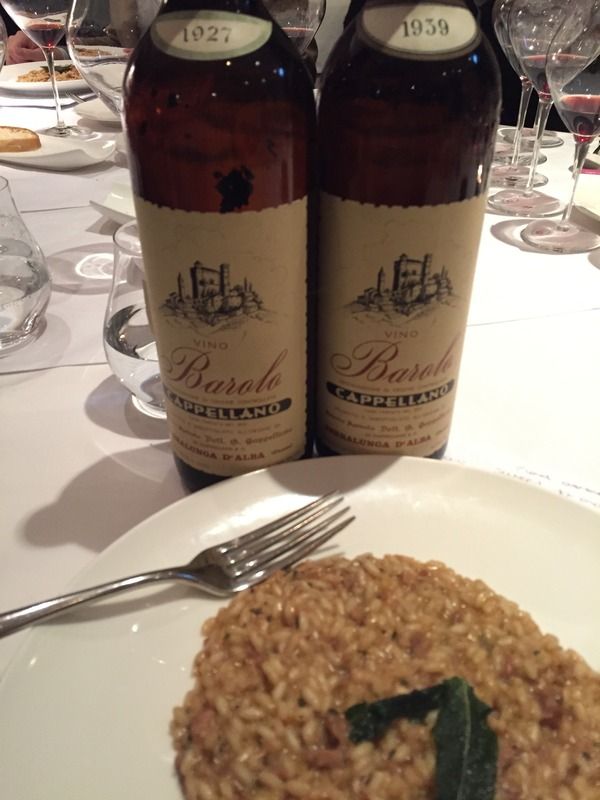
Cappellano Barolo 1927- Malt and hay, darker fruit than the '39, lifted ferrous tertiary notes leave a lower base of dried fruit and potpourri. In time becomes candied and even a per drop nuance. Classic old nebbiolo flavors, faint and lingering persistence with spice and light grip.
4th for Me and 9th for the Group.
2 Firsts, x Second, 2 x Lasts. 124pts
Cappellano Barolo 1968- Faint burnt rubber/ blackberry on first pass suggests a more significant aeration may have been in order. Burnt sugar, truffle and underbrush. Very autumnal. Kept improving over the night with more dominat sour cherry fruit, soke leather and fresher dried spices. The aromatics the highlight, the wine had very high acidity and the palate was tertiary and never freshened, keeping it pegged lower in my rankings though it was better received by the group.
8th for me and Second for the Group
3 first, 0 x Seconds or Lasts. 93pts
Cappellano Barolo 1964- Heavy soy notes, hay and herbs. Palte showed an excessive oxidative note framed with Serralunga steeliness. Enough interest on the night to rate but not the best 64 which has been excellent on previous encounters.
3 Firsts 1 x Second, 2 Lasts.
12th for me and 7th for the Group.
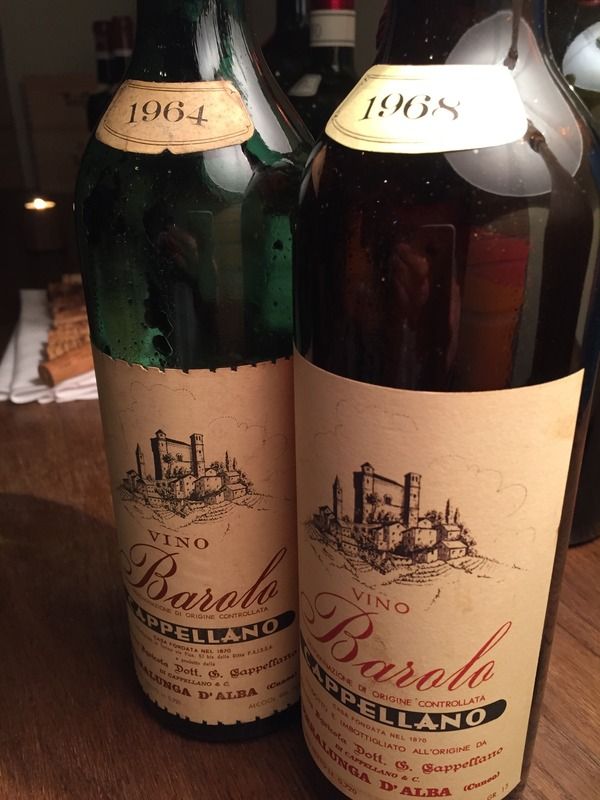
Cappellano Barolo 1993- Shy aromas, edging out mint, old spice and earth on airy menthol frd fruits. Texturally rather polished in austerity. Un-evolved though the wine is very long and tannins still commanding.
10th for Me and 11th for the Group.
0 Firsts 2 Seconds 6 Lasts 173pts
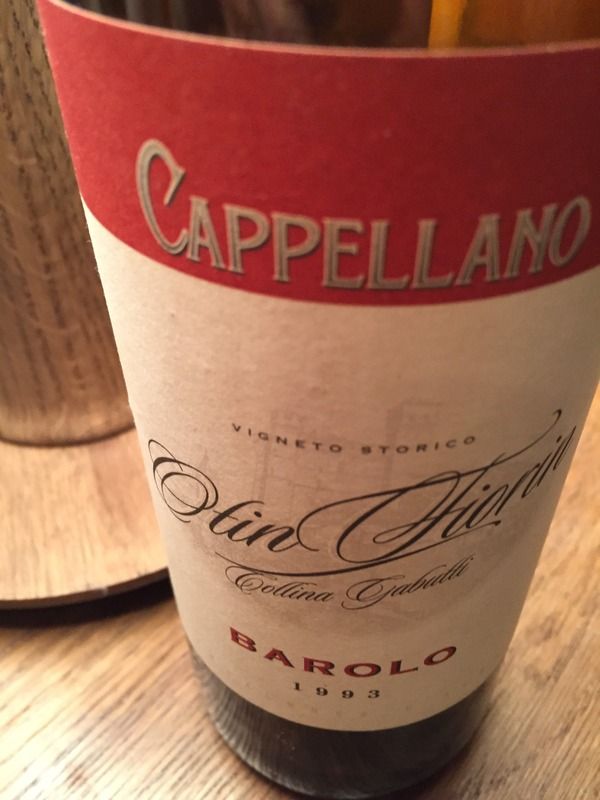
Cappellano Barolo 1978- Burnt figs, menthol and faint licorice. Spicy, elemental dark fruits. Long and grippy.
11th for Me and 12th for the Group.
0 x Firsts and Seconds 5 x Lasts. 178pts
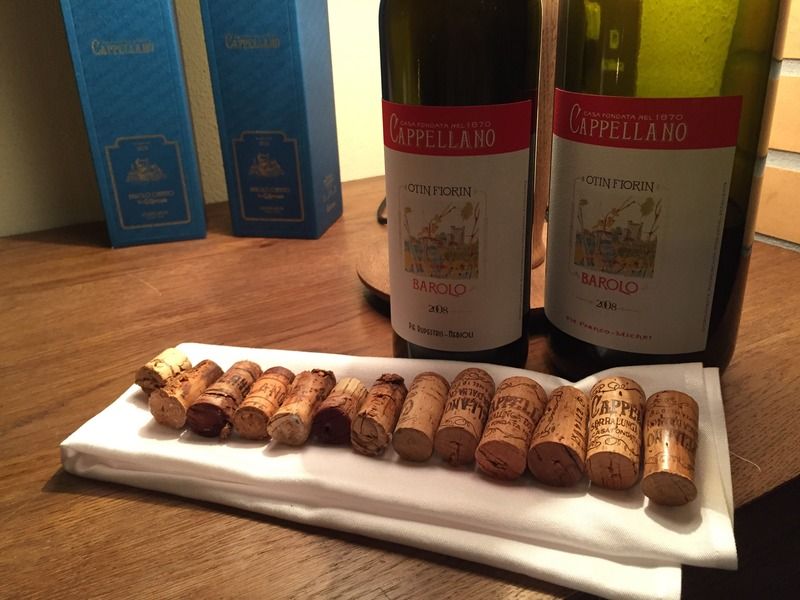
Now we have the newer vintages with a look at Franco versus Pie Rupestris.
Cappellano Barolo Piè Rupestris Otin Fiorin 2004- Soy and balsam, violet dark fruits evolve toward lighter shades, very well balanced in line and length, will uncoil a little more in time toward a classically styled Barolo.
9th for Me 4th for the Group.
2 x First 1 x Second , 1 x Last. 111pts
Cappellano Barolo Piè Rupestris Otin Fiorin 2000- Complex yet subdued florals, red and black fruits still shy, Burgundian delicacy, beautifully poised with resolved tannins holding on to a good length.
7th for Me and 6th for the Group.
1 x First, 1 x Second and No Lasts 114pts
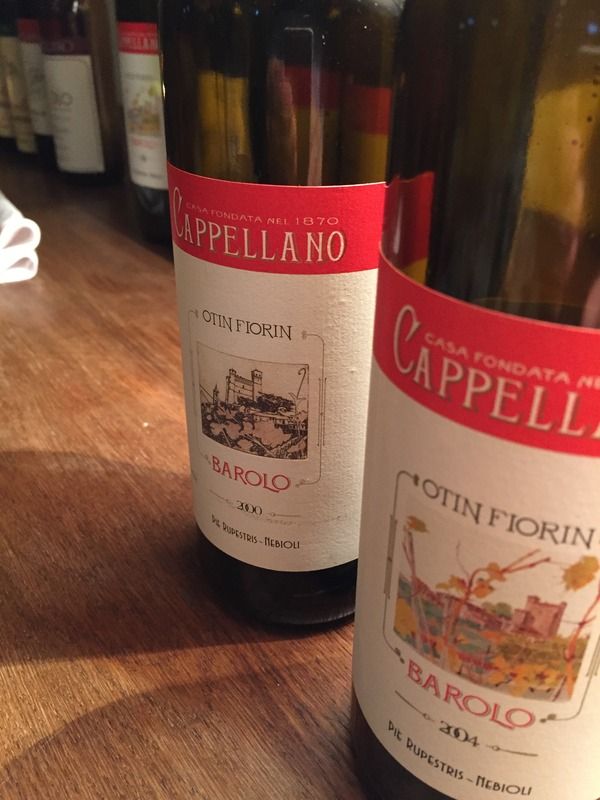
Cappellano Barolo Piè Rupestris Otin Fiorin 2010- Smokey,hallucinogenic in its deep aromatic mystique. Really something, perfectly ripened red and black fruits. Soft in the mouth yet forceful. Needs a lot of time. Long, lingering chocolate like tannins seem to differentiate it from Francos finer chalky structure. Exceptional wine.
3rd for Me and 7th for the Group.
0 Firsts or Seconds and a Last. 116pts
Cappellano Barolo Piè Franco Otin Fiorin 2010- Deep and dark, there's an abyss where the fruit is hiding. Incedible. Earth and dried flowers emerge with air. very shy, perfectly balanced and you can sense the fruit needing a decade to uncoil.
5th for Me and 10th for the Group.
Cappellano Barolo Piè Rupestris Otin Fiorin 2008 en magnum- Extraordinary wine. Open for business but will be better. Lifted, perhaps heady, tar and engine oil, very intense. Very even spread across the palate with the aromatics mimicking the palate flavors, the fruit holds on right through to a near explosive flood of fine tannin driving an incredible finish. Really something!
I drank a third of the magnum the next day and it started to shut down.
1 First 23 Seconds 0 last. 94pts
Second for Me and Third for the Group.
Cappellano Barolo Piè Franco Otin Fiorin 2008- Blood and Bone like minerality, tar and roses, tangerine high notes. Powerful and focused, very fine yet long and tight, very fine tannin structure. Too young but stunning in time.
6th for Me and 5th for the Group.
Last edited by JamieBahrain on Sat Mar 18, 2017 8:46 pm, edited 7 times in total.
"Barolo is Barolo, you can't describe it, just as you can't describe Picasso"
Teobaldo Cappellano
Teobaldo Cappellano
Re: HKWS Vertical & Horizontal of Cappellano’s Barolos: 1927 to 2010
Wonderful colour on those old wines! What a fantastic tasting. Just goes to show that vintage ratings are only a general indicator, many great wines come from 'poor' vintages. Thanks for the notes Jamie.
-
via collins
- Posts: 727
- Joined: Mon Apr 13, 2009 4:16 pm
Re: HKWS Vertical & Horizontal of Cappellano’s Barolos: 1927 to 2010
Stunning opening paragraph Jamie:
'It's hard not to be sentimental here. Harvesting of this vintage would have been in the darkest months of uncertainty in Europe. The Pact of Steel had be signed by the fascists of Germany and Italy, and the consequences of the Blitzkreig invasion of Poland through the western plains soon after must have reverberated though an impoverished rural Langhe. The region suffered terribly in WW2."
Whenever I catch train through Piedmont, I am constantly amazed at the tributes to the fallen rail workers of WW2 that occur regularly throughout the region. That fact slips to the back of my mind, but your quite stunning opening brings the sights and the emotions rushing back.
Bravo to you sir.
'It's hard not to be sentimental here. Harvesting of this vintage would have been in the darkest months of uncertainty in Europe. The Pact of Steel had be signed by the fascists of Germany and Italy, and the consequences of the Blitzkreig invasion of Poland through the western plains soon after must have reverberated though an impoverished rural Langhe. The region suffered terribly in WW2."
Whenever I catch train through Piedmont, I am constantly amazed at the tributes to the fallen rail workers of WW2 that occur regularly throughout the region. That fact slips to the back of my mind, but your quite stunning opening brings the sights and the emotions rushing back.
Bravo to you sir.
-
JamieBahrain
- Posts: 3754
- Joined: Sat Aug 16, 2003 7:40 am
- Location: Fragrant Harbour.
Re: HKWS Vertical & Horizontal of Cappellano’s Barolos: 1927 to 2010
Dinner Wines- the senses deteriorating so scribbles and comments.
Cappellano Barolo Piè Rupestris Otin Fiorin 2005- Floral ovetones, sweet and unp-front tar and roses, some sandlewood. The palate is framed by classic tar and lighter red fruits, black tea tto, prior being hollowed out with austerity and a long finish aided by fruity-grippy tannins.
Very nice wine and I feel it will hold. Augusto Cappellano suggests the wine needs drinking soon.
Cappellano Barolo Piè Rupestris Otin Fiorin 2001- My impression of the wine after coming back to it a number of times was that it was very classical. Let the wine come to you, don't go looking too hard. Scented with malt, tangerine, licorice-menthol and dark violets. Long and timeless on the palate, it continually unpeeled with air suggesting significant aeration if drinking the 2001 now, or extended cellaring, will bring benefit. Very impressed and a wine that commands its own attention and was lost a little in the "noise" of the tasting.
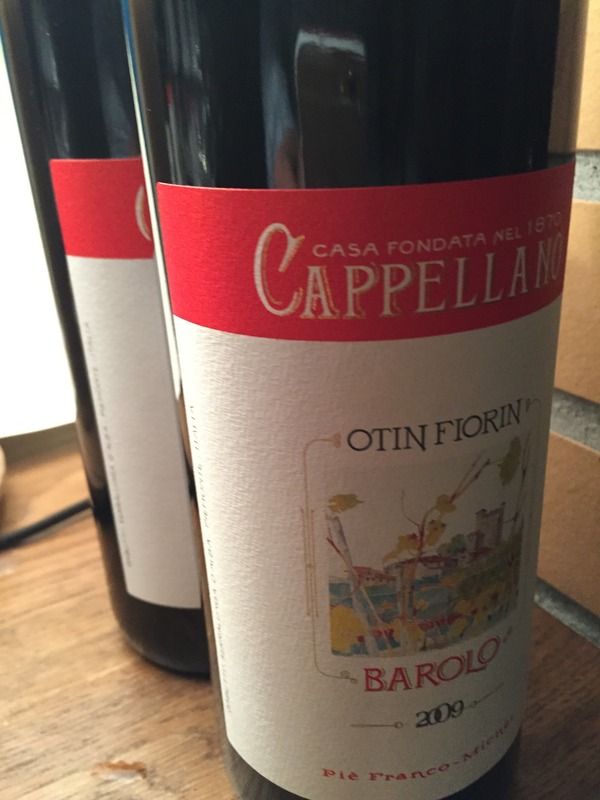
Cappellano Barolo Piè Rupestris Otin Fiorin 2009 and the Cappellano Barolo Piè Franco Otin Fiorin 2009 were completely oversgadowed by the previous. Perhaps it was to be expected that the limitations of the vintage would present after such stellar drinking.
One Franco was so volatile it was undrinkable. I've seen this a lot in nebbiolo and suspected it maybe TCA stripping the fruit and leaving VA as the dominant aroma. I don't know?
The Rupestris was approachable with boiled red lollies, light red fruits/ licorice and menthol. Has the length but not the intensity and not much suggesting there will be a significant flesh out in time. Franco was less revealing, light and lifted, delicate florals, very fine structurally.
The 2009's are perhaps being unfairly assesed. There was a lot of Barolo tonight- the wines were not bad, a Barbera would have completed better at the social end of the evening.

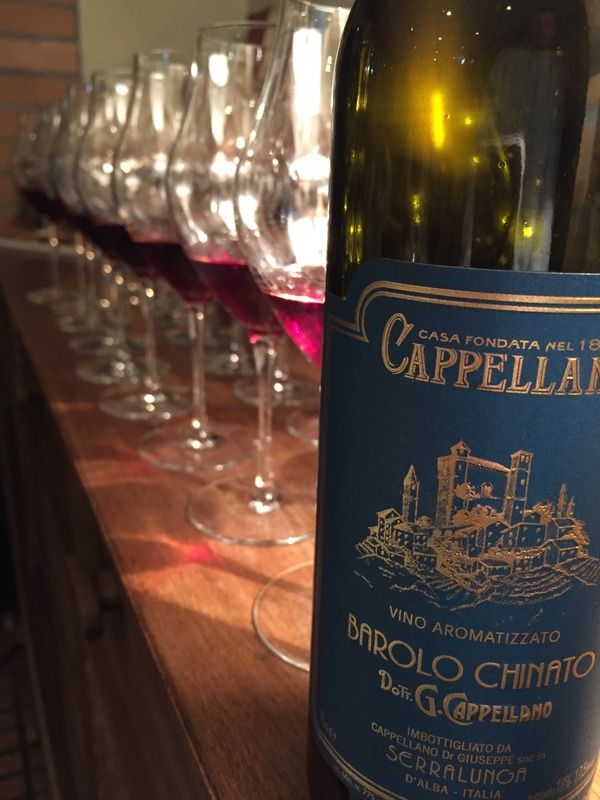
I guess you love or hate this magical elixir. I got near a full bottle pouring untouched glasses back in the bottle and taking it home. I'm off on a caving adventure deep in the jungles of Vietnam and Cappellano's Chinato should save me from Malaria.
Cappellano Barolo Piè Rupestris Otin Fiorin 2005- Floral ovetones, sweet and unp-front tar and roses, some sandlewood. The palate is framed by classic tar and lighter red fruits, black tea tto, prior being hollowed out with austerity and a long finish aided by fruity-grippy tannins.
Very nice wine and I feel it will hold. Augusto Cappellano suggests the wine needs drinking soon.
Cappellano Barolo Piè Rupestris Otin Fiorin 2001- My impression of the wine after coming back to it a number of times was that it was very classical. Let the wine come to you, don't go looking too hard. Scented with malt, tangerine, licorice-menthol and dark violets. Long and timeless on the palate, it continually unpeeled with air suggesting significant aeration if drinking the 2001 now, or extended cellaring, will bring benefit. Very impressed and a wine that commands its own attention and was lost a little in the "noise" of the tasting.

Cappellano Barolo Piè Rupestris Otin Fiorin 2009 and the Cappellano Barolo Piè Franco Otin Fiorin 2009 were completely oversgadowed by the previous. Perhaps it was to be expected that the limitations of the vintage would present after such stellar drinking.
One Franco was so volatile it was undrinkable. I've seen this a lot in nebbiolo and suspected it maybe TCA stripping the fruit and leaving VA as the dominant aroma. I don't know?
The Rupestris was approachable with boiled red lollies, light red fruits/ licorice and menthol. Has the length but not the intensity and not much suggesting there will be a significant flesh out in time. Franco was less revealing, light and lifted, delicate florals, very fine structurally.
The 2009's are perhaps being unfairly assesed. There was a lot of Barolo tonight- the wines were not bad, a Barbera would have completed better at the social end of the evening.


I guess you love or hate this magical elixir. I got near a full bottle pouring untouched glasses back in the bottle and taking it home. I'm off on a caving adventure deep in the jungles of Vietnam and Cappellano's Chinato should save me from Malaria.
"Barolo is Barolo, you can't describe it, just as you can't describe Picasso"
Teobaldo Cappellano
Teobaldo Cappellano
